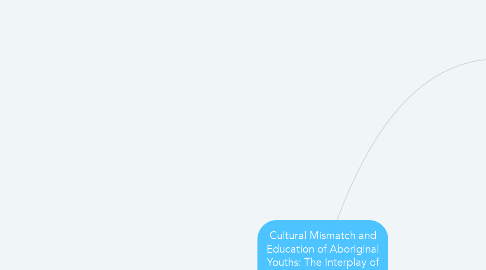
1. Cultural Models of Education
1.1. Teacher Assumptions
1.1.1. Social and Development Experiences
1.1.1.1. Resnick, L. B. (1994). Situated rationalism: Biological and social preparation for learning. In L. A.
1.1.2. Stude nt relationships:
1.1.2.1. Fryberg, S. A., & Markus, H. R. (2007). Cultural models of education in American Indian, Asian American, and European American contexts.
1.2. Motivation
1.2.1. Policies
1.2.1.1. Fryberg, S. A., & Markus, H. R. (2007). Cultural models of education in American Indian, Asian American, and European American contexts. Social Psychology of Education
1.2.1.2. Li, J. (2003). U.S. and Chinese cultural beliefs about learning.
1.2.2. Interdependent: Peer
1.2.2.1. Individual
1.2.2.1.1. Henrich, J., Heine, S. J., & Norenzayan, A. (2010). The weirdest people in the world? Behavioral and Brain Sciences
1.2.2.2. Henrich, J., Heine, S. J., & Norenzayan, A. (2010). The weirdest people in the world? Behavioral and Brain Sciences
1.2.2.3. Markus, H. R., Mullally, P., & Kitayama, S. (1997). Selfways: Diversity in modes of cultural participation. In U. Neisser & D. Jopling (Eds.), The conceptual self in context: Culture, experience, self-understanding
1.2.2.4. Aboriginal Students
1.2.2.4.1. Fryberg, S. A., & Markus, H. R. (2007). Cultural models of education in American Indian, Asian American, and European American contexts.
1.2.2.4.2. Gloria, A. M., & Robinson Kurpius, S. E. (2003). Influence on self-beliefs, social support, and comfort in the university environment on the academic persistence.
1.2.2.4.3. LaFromboise, T., Hoyt, D., Oliver, L., & Whitbeck, L. (2006). Family, community, and influences on resilience among American Indian adolescents in the upper Midwest.
1.2.2.4.4. Swisher, K. G., & Tippeconnic, J. W. (Eds.). (1999). Next steps: Research and practice to advance Indian education. Charleston,
1.2.2.4.5. Tierney, W. G. (1992). Official encouragement, institutional discouragement: Minorities in academe–The Native American experience
1.2.2.4.6. Triandis, H. C., Bontempo, R., Villareal, M. J., Asai, M., & Lucca, N. (1988). Individualism and collectivism: Cross-cultural perspectives on self-in group relationships
1.2.2.5. Cognition, Motivation, and achievement:
1.2.2.5.1. Demmert, W. G., & Towner, J. C. (2003). A review of the research literature on the influences of culturally based education on the academic performance of Native American students.
2. Westernized Education
2.1. Discrimination
2.1.1. Pewewardy, C. (2002). Learning styles of American Indian/Alaska Native students: A review of the literature and implications for practice
2.2. Cultural Divide
2.2.1. Fryberg, S. A., Covarrubias, R., & Burack, J. A. (in press). Cultural models of education and academic performance for Native American and European American students
2.2.2. Stephens, N. M., Fryberg, S. A., Markus, H. R., Johnson, C. S., & Covarrubias, R. (2012, March 5). Unseen disadvantage: How American universities’ focus on independence undermines the academic performance of first-generation college students.
2.3. Cultural Matching/ Mismatch
2.3.1. Stephens, N. M., Fryberg, S. A., Markus, H. R., Johnson, C. S., & Covarrubias, R. (2012, March 5). Unseen disadvantage: How American universities’ focus on independence undermines the academic performance of first-generation college students.
3. Aboriginal Youth Education
3.1. Individual Cultural Identification and Belonging
3.1.1. Brown, D. L., & Tylka, T. L. (2011). Racial discrimination and resilienc in African American young adults: Examining racial socialization as a moderator
3.1.2. ap, S. C., Settles, I. H., & Pratt-Hyatt, J. S. (2011). Mediators of the relationship between racial identity and life satisfaction in a community sample of African American women and men.
3.1.3. Cohen, G. L., & Garcia, J. (2005). I am us: Negative stereotypes as collective threats.
3.1.4. Oyserman, D., Kemmelmeier, M., Fryberg, S., Brosh, H., & Hart-Johnson, T. (2003). Racial-ethnic self-schemas.
3.1.5. Deyhle, D. (1992). Constructing failure and maintaining cultural identity: Navajo and Ute school leavers
3.1.6. Trueba, H. T. (1993). From failure to success: The roles of culture and cultural conflict in the academic achievement of Chicano students.
3.2. Traditional Culture
3.2.1. Whitbeck, L., Hoyt, D., Stubben, J., & LaFromboise, T. (2001). Traditional culture and academic success among American Indian children in the upper Midwest.
3.2.2. Deyhle, D., & Margonis, F. (1995). Navajo mothers and daughters: Schools, jobs, and the family.

